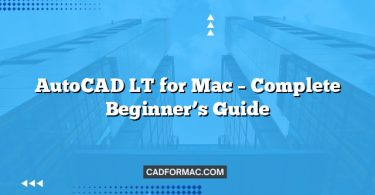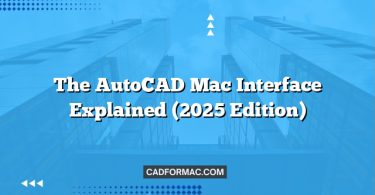AutoCAD for Mac brings the industry-standard CAD software to Apple’s ecosystem, but navigating it efficiently requires mastering a blend of macOS-native shortcuts and AutoCAD-specific commands. Whether you’re a seasoned drafter or new to AutoCAD on Mac, learning the right keyboard combinations can dramatically boost your productivity and streamline your workflow.
Unlike the Windows version of AutoCAD, which relies heavily on function keys and Ctrl-based shortcuts, the Mac version integrates more closely with macOS conventions—using the ⌘ (Command) key instead of Ctrl and adapting to macOS window management. This guide covers the most essential shortcuts every AutoCAD Mac user should know, categorized for clarity and ease of reference.
Core Navigation & View Controls
Efficient navigation is the backbone of any CAD workflow. These shortcuts help you pan, zoom, and rotate your view without reaching for the mouse.
- Zoom In:
⌘ + +(plus sign) - Zoom Out:
⌘ + –(minus sign) - Zoom Extents (fit all objects to screen):
⌘ + 0 - Pan: Hold
Spacebarand drag - Orbit (3D view):
⌘ + Dragwith middle mouse button (orOption + Dragif using a trackpad) - View Previous:
⌘ + [ - View Next:
⌘ + ]
Tip: If you’re using a Magic Mouse or trackpad, enable “Secondary Click” in System Settings to simulate right-click for context menus.
Drawing & Editing Commands
Speed up your drafting by launching common tools directly from the keyboard.
- Line: Type
LthenEnter - Circle: Type
CthenEnter - Rectangle: Type
RECthenEnter - Polyline: Type
PLthenEnter - Offset: Type
OthenEnter - Trim: Type
TRthenEnter - Extend: Type
EXthenEnter - Move: Type
MthenEnter - Copy: Type
COthenEnter - Rotate: Type
ROthenEnter - Mirror: Type
MIthenEnter
Note: AutoCAD Mac uses command-line input by default. Press
EnterorSpacebarto confirm commands—both work identically.
Selection & Object Manipulation
Precise object selection is critical in complex drawings.
- Select All:
⌘ + A - Deselect All:
Esc - Cycle Through Overlapping Objects: Hold
Shiftand click repeatedly on the same spot - Add to Selection: Hold
Shiftwhile clicking objects - Remove from Selection: Hold
⌘ + Shiftwhile clicking selected objects
File Management & Interface
Keep your workspace organized and files under control.
- New Drawing:
⌘ + N - Open Drawing:
⌘ + O - Save:
⌘ + S - Save As:
⌘ + Shift + S - Print:
⌘ + P - Close Current Drawing:
⌘ + W - Quit AutoCAD:
⌘ + Q - Toggle Command Line:
⌘ + 9 - Toggle Properties Palette:
⌘ + 1 - Toggle Layers Palette:
⌘ + 2 - Toggle Tool Palettes:
⌘ + 3
Undo, Redo & Recovery
Mistakes happen—fix them instantly.
- Undo:
⌘ + Z - Redo:
⌘ + Yor⌘ + Shift + Z - Repeat Last Command:
EnterorSpacebar(after completing a command)
AutoCAD Mac supports multiple levels of undo, so you can step back through several actions if needed.
Customization Tips
AutoCAD for Mac allows you to personalize your shortcut experience:
- Custom Keyboard Shortcuts:
Go to AutoCAD > Preferences > User Preferences > Keyboard Shortcuts to assign or modify shortcuts. - Use Alias Shortcuts:
Many commands have built-in aliases (e.g.,Lfor LINE). You can edit these in the acad.pgp file (found in the Support folder) to create your own. - Enable Function Keys:
On newer MacBooks, function keys (F1–F12) control system features by default. To use them as standard function keys in AutoCAD:- Go to System Settings > Keyboard
- Check “Use F1, F2, etc. keys as standard function keys”
- Now you can use
F8for Ortho mode orF3for Object Snap if desired
Bonus: macOS Integration Shortcuts
Take advantage of macOS features while working in AutoCAD:
- Mission Control:
F3orCtrl + ↑— quickly switch between open applications - App Exposé:
Ctrl + ↓— see all AutoCAD windows at once - Spotlight Search:
⌘ + Space— launch other apps or find files without leaving AutoCAD - Copy/Paste Between Apps:
⌘ + C/⌘ + Vworks seamlessly with other macOS apps like Preview or Notes
Frequently Asked Questions (FAQ)
Can I use the same keyboard shortcuts in AutoCAD for Mac as in AutoCAD for Windows?
Not exactly. While many command aliases (like L for LINE or C for CIRCLE) are identical, keyboard shortcuts that rely on modifier keys differ significantly. AutoCAD for Windows uses Ctrl for most shortcuts (e.g., Ctrl + S to save), whereas AutoCAD for Mac follows macOS conventions and uses the ⌘ (Command) key instead (e.g., ⌘ + S). Additionally, some Windows-specific shortcuts (like Ctrl + 1 for Properties) are remapped to ⌘ + 1 on Mac. Always refer to the Mac-specific documentation when switching platforms.
Why don’t the F1–F12 function keys work as expected in AutoCAD for Mac?
By default, modern Macs assign system functions to the F1–F12 keys (e.g., brightness, volume, Mission Control). To use them as standard function keys for AutoCAD commands (like F8 for Ortho mode), you must either:
- Hold the
Fnkey while pressing the function key (e.g.,Fn + F8), or - Go to System Settings > Keyboard and enable “Use F1, F2, etc. keys as standard function keys.”
Once enabled,F8will work directly without theFnkey.
Is there a way to import my Windows AutoCAD shortcut customizations to the Mac version?
Unfortunately, no. AutoCAD for Mac uses a different shortcut architecture and preference file structure than the Windows version. Custom .cuix or .pgp files from Windows aren’t directly compatible. However, you can manually recreate your preferred aliases by editing the acad.pgp file located in the AutoCAD Support folder on your Mac, and reassign keyboard shortcuts via AutoCAD > Preferences > User Preferences > Keyboard Shortcuts.
How do I access the right-click context menu on a Mac without a two-button mouse?
If you’re using a Magic Mouse, trackpad, or single-button mouse:
- Trackpad: Tap with two fingers or click with two fingers (enable in System Settings > Trackpad > Point & Click > Secondary Click).
- Magic Mouse: Click on the right side of the mouse (ensure Secondary Click is enabled in System Settings > Mouse).
- Keyboard alternative: Press
Ctrl + Clickto simulate a right-click anywhere in the drawing area.
Can I use AutoCAD Mac shortcuts while working in full-screen mode?
Yes! AutoCAD for Mac fully supports macOS full-screen mode, and all keyboard shortcuts continue to work normally. However, some macOS system gestures (like swiping between spaces) might interfere with trackpad-based navigation in AutoCAD. If this happens, consider disabling conflicting gestures in System Settings > Trackpad or use a mouse for 3D orbit and pan operations.
Are there any Mac-exclusive AutoCAD features tied to keyboard shortcuts?
While most core functionality is cross-platform, AutoCAD for Mac integrates more deeply with macOS features. For example:
⌘ + Tabswitches between AutoCAD and other open Mac apps seamlessly.⌘ + Hhides AutoCAD (a macOS standard), which isn’t available in the same form on Windows.- The
⌘ + \shortcut toggles the Mac-native Sheet Set Manager panel if enabled.
These aren’t “exclusive tools,” but they reflect macOS-native behavior that enhances workflow on Apple hardware.
Final Thoughts
Mastering these shortcuts won’t just save you time—it will transform how you interact with AutoCAD on Mac. Start by integrating a few into your daily routine, then gradually adopt more as they become second nature. Remember, the most efficient users aren’t necessarily the fastest typists; they’re the ones who minimize mouse dependency and keep their hands on the keyboard.
For a printable reference, consider creating a custom cheat sheet or using AutoCAD’s built-in Keyboard Shortcuts manager to keep your most-used commands at your fingertips.




